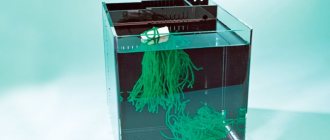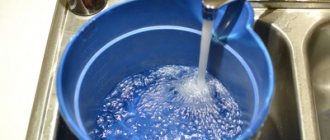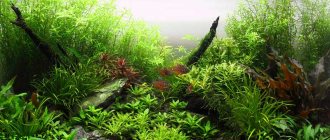When buying new fish, even an experienced aquarist may not notice the signs of a sick fish. And this is not a shame, because fish carrying pathogens are almost impossible to identify during external examination. And once in the aquarium, most ectoparasites, equipped with segmented legs, cilia, and flagella, freely move from sick fish to healthy ones. No store-bought guarantees of fish cleanliness will relieve you, as a caring aquarist, from a set of preventive measures - fish quarantine, during which newcomers are carefully observed, their covers are examined, and so on. Quarantine fish for a fairly long period of time.
Why do aquarium fish need quarantine?
When buying fish, it is difficult to determine the presence of infection or parasites at first glance. It is almost impossible to recognize an unhealthy individual during a routine external examination. Fish can be a hidden carrier of the disease for a long time. The stress that pets experience when changing living conditions reduces immunity, and then the disease makes itself felt. Some diseases have a long incubation period. Infected fish are a threat to the aquarium, and before placing it with the rest of the inhabitants, it is necessary to undergo a quarantine lasting from two weeks to a month. The behavior and appearance of the fish are carefully observed throughout the entire period. If signs of the disease appear, treatment is carried out.
If individual inhabitants of the main aquarium have health problems, which can be determined by a change in behavior and change in appearance, they need to be resettled for a while. During quarantine, the fish undergo treatment.
Why do the leaves of plants in an aquarium turn brown?
Good aeration and water filtration will stop their growth. Timely removal of food debris and dirt helps keep the water clean. If you notice brown growths appearing in the tank, it means that brown algae has settled in it.
Interesting materials:
How to write text upside down in Excel? How to enter multiple lines of text into one cell in Excel? How to bring text to foreground in Photoshop? How to write text in Paint Net? How to turn text upside down in a table? How to find a non-breaking space in a text? How to send a photo with text on WhatsApp? How to add text online to a video? How to write text at the top of a table in Word? How to underline text with two lines in Word?
Basic requirements for a quarantine worker
What does fish quarantine mean? First of all, in a quarantine aquarium there are completely different conditions for keeping. Aqua is chosen as a quarantine tank depending on the species preferences of the fish. To give you an example of this? Well, let’s say for two adult goldfish, you will need 50-60 liters of aqua, but for a dozen cherry barbs, a 20 liter jar will be enough for you.
As a rule, soil is not placed in a quarantine aquarium, and plants are not planted because there is nowhere. The only thing that is useful for such an aqua is various shelters for fish. This will help reduce stress. Alternatively, you can use a small number of plastic plants. The main thing is that all decorative elements and shelters do not hide almost the entire space of the aquarium from your view and you can monitor the condition of the inhabitants of the aqua.
A mandatory attribute in a quarantine aquarium is a heater, thermometer, filter and, of course, a lid with a lamp. In order for the fish to calm down faster and experience as little stress as possible, place a quarantine aquarium somewhere not on the walkway. The fish will not be very comfortable if the door next to the jar is constantly slamming.
If suddenly, after a couple of weeks spent in quarantine, you have a suspicion, but you do not see any visible signs of illness on your body, if the fish have become depressed, very shy and not very active, do not stop quarantine. Better watch the animals for a few more weeks.
But if the fish is already clearly sick, then it should be removed from the quarantine facility and treatment should begin with stronger doses of medications. During quarantine, you will need to change the water not once a week, as is usually the case in a community aquarium, but several times. Do not forget about intensive aeration and filtration. The use of activated carbon is not necessary; you can only treat the sponge and rinse it more often under warm water every 3 days.
Aquarium equipment for quarantine
water heater; lighting; artificial plants so that the quarantine can be carried out comfortably and they have the opportunity to hide; filter for water purification. Only after the fish quarantine aquarium has been prepared can you go and buy new inhabitants for your home pond.
Artificial plants for the aquarium - how to prepare them so that they look like real ones?
Over the past few decades, aquarium science has come a way in which the presence of live plants in the aquarium can be replaced by artificial ones. Aquarists have divided opinions about artificial plants. Most of them prefer living plants, emphasizing their undeniable advantages.
Artificial aquarium plants have many benefits and are an excellent alternative to natural plants. They will work especially when it is impossible to eat live plants. Before you begin your adventure with artificial aquarium plants, it is worth learning as much as you can about them so that you can use them correctly and enjoy their charm.
Artificial aquarium plants - what are they?
These days, artificial aquarium plants look just like the real thing. They don't differ in color, shape or even how they behave in water. They perfectly reproduce the natural shapes, leaf textures and colors of living plants. There are many artificial aquarium plants on the market. It is worth choosing the best ones, which are made of high-quality materials, which contributes to their durability and the fact that they retain their appearance for a long time. What's more, artificial aquarium plants are more affordable than natural plants, and you can achieve some truly amazing visual effects with them.
Aquarium interior design can be fun, and its effect should serve its aesthetic function - a beautifully designed aquarium is part of the interior design of the apartment, which will become its undoubted decoration. The most important function of aquarium plants, live or artificial, is to provide the fish with an environment in which which they feel safe. How Lush and interestingly arranged plant decorations provide shelter for fish from threats from the outside world. With artificial aquarium plants, you don't have to cycle your hands into the water and scare the fish.
Artificial plants for the aquarium - pros and cons
Artificial aquarium plants have many benefits that support their use. They can be especially useful for beginner aquarists because they do not require much care or attention. What are the benefits of artificial plants for aquariums?
They don't die, get too big, fall off the ground, or become unattractive due to poor care;
· They are easy to clean - they can be easily removed and also remove dirt or algae;
· There are no light requirements for them, thanks to which we save on light and energy;
· Do not bring parasites with you, do not rot or pollute the tank;
· They will not be eaten by fish, thanks to which the bitten plants will not float in the aquarium;
· They are cheaper to maintain - we save on fertilizers that do not need to be used;
· Less stress for the fish - no work associated with trimming or planting;
· Less time – quick and lasting arrangement effect.
Disadvantages of artificial aquarium plants:
· Do not absorb carbon dioxide;
· Does not release oxygen;
· Do not perform the same biological functions as living plants - they are not food for plants;
· Do not interfere with the growth of algae;
· They cannot be taken care of, which in itself can be a pleasure for aquarists;
· Does not absorb toxins;
· Some of them may look artificial - they are exaggerated and unnatural in shape;
· Do not create an environment for the development of beneficial bacteria.
How to prepare artificial plants for an aquarium?
Trusted brands and good materials are the best guide when purchasing artificial plants. It's worth remembering not to pour boiling water over them and cook them! Doing so can cause them to lose texture and color, but most importantly, contact with boiling water can release harmful chemicals that can be fatal to the fish. When buying artificial plants for an aquarium, you should pay attention to their smell - it should not be too strong.
Before putting them in the aquarium, they must be washed thoroughly - first in running water, and then in hot but not boiling water, additionally without using any chemicals or soap. What else is worth remembering when preparing artificial plants for an aquarium? They need to hide the necessary equipment that is in the aquarium. To do this, choose long and dense plants that will cover all filters and heaters. When thinking about light, it is worth remembering that artificial aquarium plants do not require additional lighting; it is enough to use ordinary aquarium fluorescent lamps.
Artificial aquarium plants are a very good alternative to live plants. They are less labor intensive and require little preparation to place them in the aquarium. Most importantly, they fulfill their primary function - they create a safe environment in which fish live. For these reasons, artificial aquarium plants are a good choice for beginner aquarists and many others.
Types of quarantine
There are two types of quarantine classified by duration: short (2 weeks) and long (1 month). For fish caught in natural reservoirs, the quarantine period is much longer: up to three months may be needed to get rid of all parasites and ensure the absence of viral and bacterial diseases. In accordance with the conditions of keeping individuals in quarantine, three types of isolation are distinguished:
- Preventive quarantine involves carrying out therapeutic and preventive measures in the absence of signs of disease in pets. The use of special preparations can reduce the quarantine period for new fish to two weeks.
- Passive quarantine is carried out in compliance with normal conditions of detention without the use of preventive and therapeutic agents. The quarantine period is at least three weeks. When diseases are detected, quarantine is transferred to the active phase.
- Active quarantine involves the use of therapeutic measures that continue until the pets recover or die. The duration of the course depends on the disease. Upon completion of treatment of infected pets, disinfection of the aquarium and equipment is required.
Determining the quarantine period
It is advisable to use complete quarantine, that is, keep the fish in a special jar for at least a month. You're not in a hurry, are you? And why is there any rush in this matter? It’s better to do everything right and without unnecessary hassle than to rush and find yourself another headache. If you miss, or cannot keep the fish in quarantine, then in the event of an outbreak of disease, it is extremely difficult to cure the inhabitants in a general aquarium, and in some cases it is completely impossible. I hope you agree with me?
Anti-parasitic baths after quarantine ends
It can be difficult to detect the presence of some parasites and infections even during the quarantine period. Therefore, it makes sense to carry out preventive antiparasitic treatment with one of the solutions immediately before adding pets to a functioning aquarium:
- malachite green in a proportion of 6 mg per 10 liters of water;
- potassium permanganate 1 g per 10 liters of water;
- copper sulfate 1 g per 10 liters of water;
- bicillin-5 50000BD per 10 liters of water.
After the bath, the fish are placed in clean water to wash away any remaining solution, and then they can be transferred to the aquarium.
Nastena
Before placing in an aquarium, it is recommended to disinfect newly acquired plants, even those purchased from a safe aquarium. Algae, snails, coelenterates, protozoa, and pathogens can begin to flourish in your aquarium, whereas they were suppressed in the source aquarium. Those purchased at the market, in a pet store, with signs of algae, etc., must be disinfected.
Tap water The simplest method is daily soaking in raw tap water. The water is chlorinated, every little thing dies. Does not affect melania snails and hard algae such as thread and black beard. But for plants from a healthy aquarium it is quite suitable.
Potassium permanganate solution A light pink solution of potassium permanganate, potassium permanganate, is suitable for disinfection. Exposure time 30 - 90 minutes. Can be combined with the first method.
Hydrogen peroxide Hydrogen peroxide effectively destroys all algae, snails, protozoa, and pathogens. I recommend it for plants affected by algae and taken from dubious sources. 5 ml of 3% peroxide is added to 10 liters of water and left for 30 - 40 minutes. For black beards and flip-flops, re-treatment is required every other day.
Therapeutic and prophylactic solutions for quarantine
The use of medications during quarantine is not recommended for novice aquarists! If the fish behave calmly and do not show any signs of disease, you should not use preventive measures. At the end of the quarantine period, healthy pets are transferred to a common aquarium.
To treat diseases, there are various ready-made drugs that are used in accordance with the instructions. If the pet is unwell, but the disease cannot be determined, well-known and effective methods can be used. Substances used for treatment have a certain degree of toxicity. Using them incorrectly can cause harm to the fish.
Salt baths
A concentrated saline solution is effective in combating saprolegniosis, a fungal disease and ectoparasitic infestations such as apiosomosis, hydrodactylosis, costiosis, chylodonellosis, tetrachymenosis, dactylogyrosis, oodiniumosis, trichodinosis. The presence of ectoparasitic invasions is determined by the behavior of the fish: they try to scratch themselves on the ground, plants, and decor. The body is covered with whitish mucus. Pets stop moving calmly throughout the entire volume of the aquarium and most often stay in corners or near the aerator. A sign of saprolegniosis is the presence of fluffy growths on the fins and lips.
To carry out the procedure, you will need 3 vessels with water. You can use water from an aquarium, or take tap water and prepare it as follows:
- heat to 80% temperature;
- cool to the temperature maintained in the aquarium;
- Aerate for 30 minutes.
In the first container, add a saline solution with a concentration of 2% (2 teaspoons of salt per 1 liter of water). The second vessel is filled with a weak saline solution (0.5 teaspoon of salt per 1 liter of water). In the third vessel, dissolve a small amount of potassium permanganate until it turns pale pink.
First, you should test the medicinal bath on a separate, less valuable individual. It is placed in the first container. Salt bath time: 10–15 minutes. The behavior of the fish will indicate that the fish is not feeling well: if the fish floats to the surface, begins to move on its side and is unable to submerge in the water, then the procedure should be stopped. If the solution has the correct concentration, the fish will behave as usual.
After 10–15, the fish is transplanted into a container with a weak saline solution. If there are still parasites on the individual, there is a chance that they will be completely destroyed. You can leave the fish directly in the net, rinse it in the solution and transfer it to the third vessel and also do a quick rinse, after which you can release the pet back into the aquarium.
To completely get rid of the listed diseases, it is necessary to carry out 2-3 salt baths, maintaining an interval of several days.
Formaldehyde baths
Formalin is an effective broad-spectrum antiparasitic agent. To prepare a medicinal solution, take 1 ml of formaldehyde per 5–6 liters of water. As in the previous recipe, it is recommended to first test on an individual individual. The poor condition of the fish can be determined by its falling to one side and convulsions. In this case, the pet is urgently moved to clean water. If the test result is positive, the bath is carried out for 12–15 minutes.
Ammonia baths
Ammonia baths help get rid of dactylogyrus, hydrodactylus and other ecoparasites. Ammonia is highly toxic, so the concentration and time of the procedure must be carefully observed. For therapeutic and prophylactic measures, two containers will be required. The first will contain an ammonia solution, the second will contain methylene blue dye diluted in water.
For the solution, take 8 liters of water.
Pharmaceutical ammonia is added to it in an amount of 6.3 ml. Or use ammonia from a chemical store. It is more concentrated (25–27%), so for 8 liters of water you will need only 2.5–3 ml.
The first test must be carried out on one fish. The temperature of the ammonia bath water must be maintained between 18–25 degrees. Procedure time: 20–25 seconds. Under no circumstances should the maximum bath duration be exceeded!
At the end of the procedure, the fish is transferred to a second vessel with a solution of methylene blue. The concentration of the ammonia bath is considered satisfactory if the individual begins to swim normally in the second vessel within the first minute. If necessary, you can reduce the time of the ammonia bath or reduce the concentration.











